Country Risk Analysis for Tower Associates: A Case Study
VerifiedAdded on 2022/10/07
|6
|1253
|21
Case Study
AI Summary
This case study analyzes the country risk for investment decisions, focusing on the challenges faced by Susan Brede, a senior partner at Tower Associates, a private equity firm aiming to expand into emerging markets. The analysis emphasizes the importance of considering currency crises, financial crises, and foreign debt crises as critical indicators of a country's economic status. The study examines the domestic and economic situations of four countries (A, B, C, and D), evaluating their economic policies, including macroeconomic stability and diversification. The case highlights the need to assess factors such as inflation rates, natural resource dependency, and government interventions to make informed investment decisions. The analysis also discusses the importance of diversifying from agriculture and fostering free market supply-side policies. References are provided to support the analysis of economic risk.
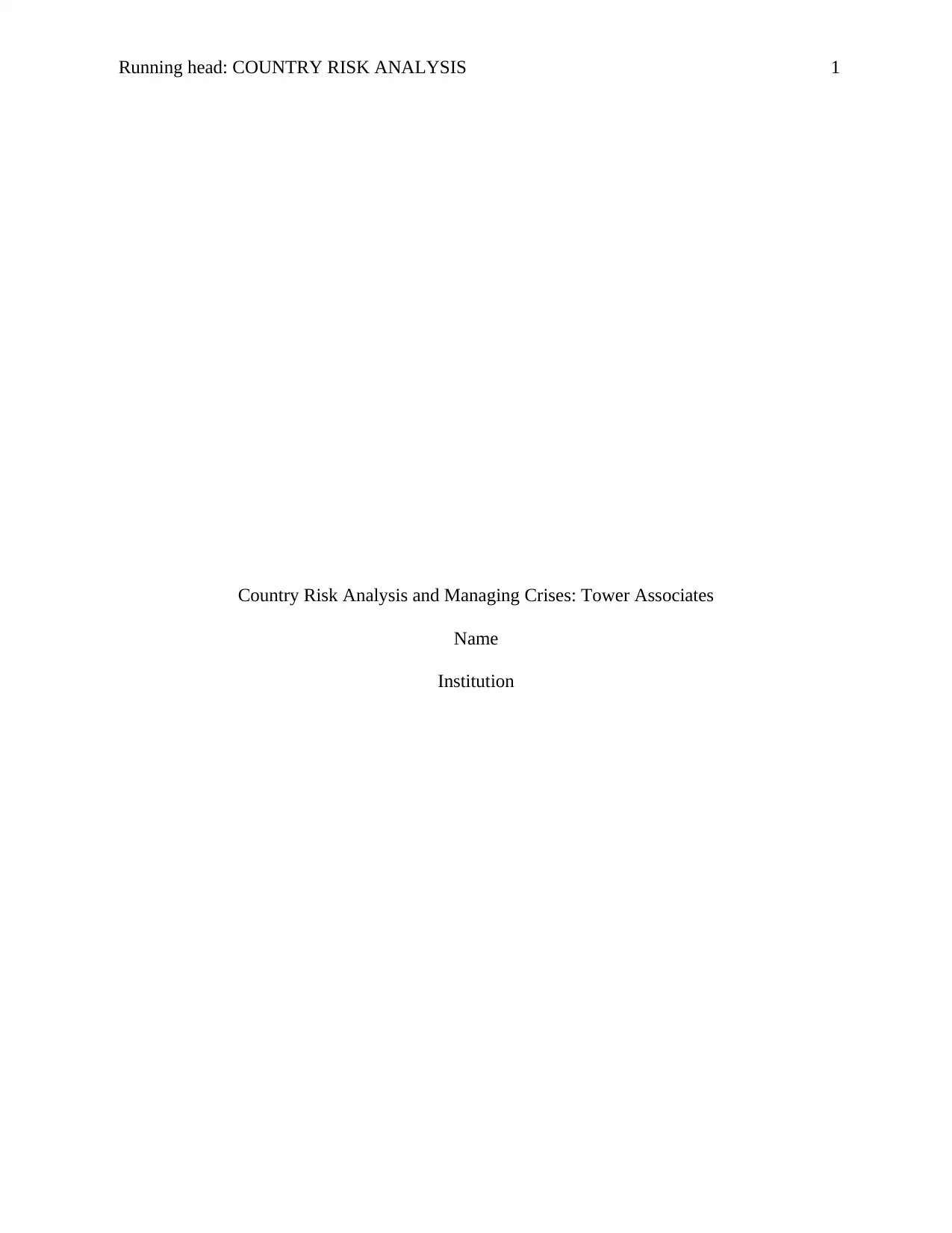
Running head: COUNTRY RISK ANALYSIS 1
Country Risk Analysis and Managing Crises: Tower Associates
Name
Institution
Country Risk Analysis and Managing Crises: Tower Associates
Name
Institution
Paraphrase This Document
Need a fresh take? Get an instant paraphrase of this document with our AI Paraphraser
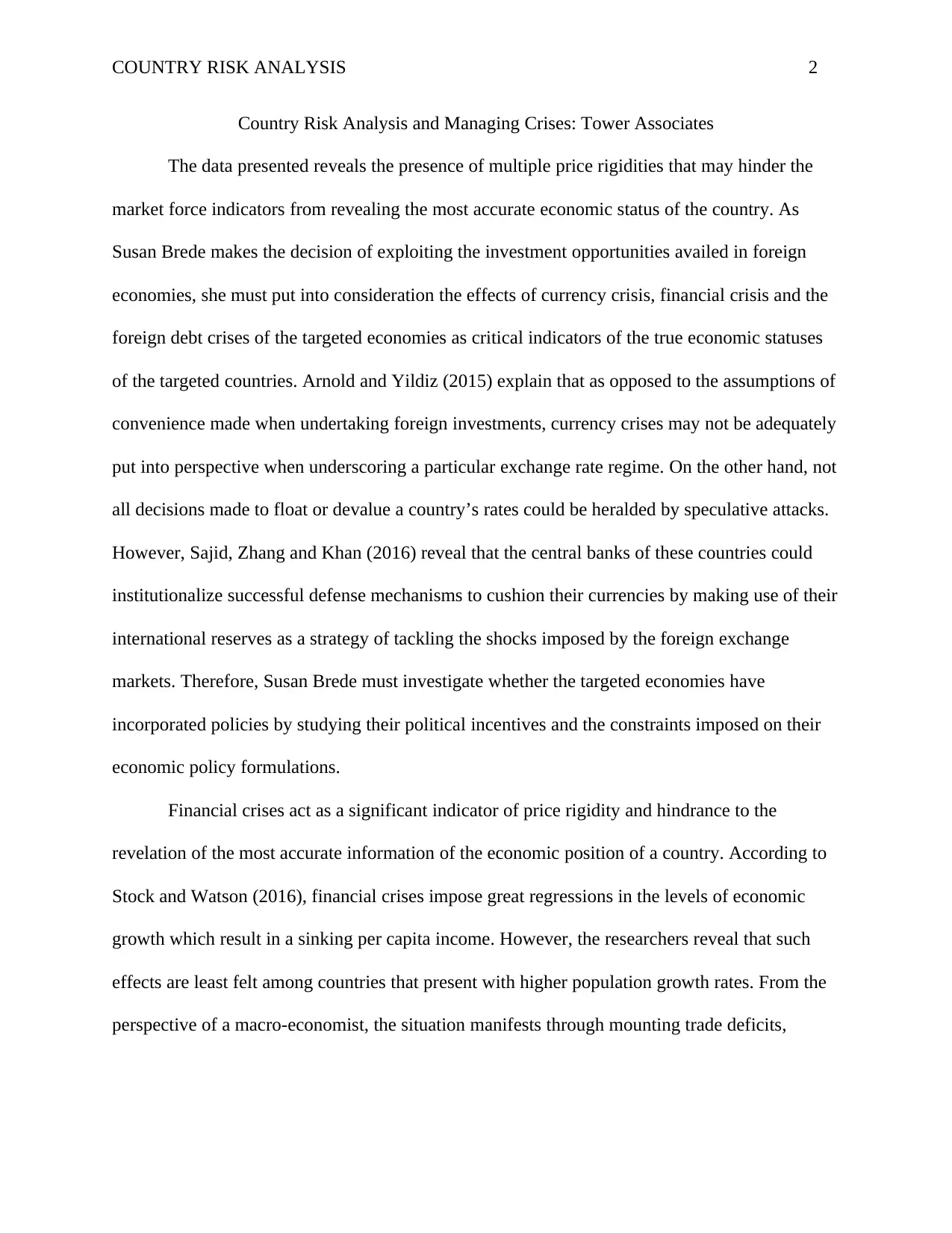
COUNTRY RISK ANALYSIS 2
Country Risk Analysis and Managing Crises: Tower Associates
The data presented reveals the presence of multiple price rigidities that may hinder the
market force indicators from revealing the most accurate economic status of the country. As
Susan Brede makes the decision of exploiting the investment opportunities availed in foreign
economies, she must put into consideration the effects of currency crisis, financial crisis and the
foreign debt crises of the targeted economies as critical indicators of the true economic statuses
of the targeted countries. Arnold and Yildiz (2015) explain that as opposed to the assumptions of
convenience made when undertaking foreign investments, currency crises may not be adequately
put into perspective when underscoring a particular exchange rate regime. On the other hand, not
all decisions made to float or devalue a country’s rates could be heralded by speculative attacks.
However, Sajid, Zhang and Khan (2016) reveal that the central banks of these countries could
institutionalize successful defense mechanisms to cushion their currencies by making use of their
international reserves as a strategy of tackling the shocks imposed by the foreign exchange
markets. Therefore, Susan Brede must investigate whether the targeted economies have
incorporated policies by studying their political incentives and the constraints imposed on their
economic policy formulations.
Financial crises act as a significant indicator of price rigidity and hindrance to the
revelation of the most accurate information of the economic position of a country. According to
Stock and Watson (2016), financial crises impose great regressions in the levels of economic
growth which result in a sinking per capita income. However, the researchers reveal that such
effects are least felt among countries that present with higher population growth rates. From the
perspective of a macro-economist, the situation manifests through mounting trade deficits,
Country Risk Analysis and Managing Crises: Tower Associates
The data presented reveals the presence of multiple price rigidities that may hinder the
market force indicators from revealing the most accurate economic status of the country. As
Susan Brede makes the decision of exploiting the investment opportunities availed in foreign
economies, she must put into consideration the effects of currency crisis, financial crisis and the
foreign debt crises of the targeted economies as critical indicators of the true economic statuses
of the targeted countries. Arnold and Yildiz (2015) explain that as opposed to the assumptions of
convenience made when undertaking foreign investments, currency crises may not be adequately
put into perspective when underscoring a particular exchange rate regime. On the other hand, not
all decisions made to float or devalue a country’s rates could be heralded by speculative attacks.
However, Sajid, Zhang and Khan (2016) reveal that the central banks of these countries could
institutionalize successful defense mechanisms to cushion their currencies by making use of their
international reserves as a strategy of tackling the shocks imposed by the foreign exchange
markets. Therefore, Susan Brede must investigate whether the targeted economies have
incorporated policies by studying their political incentives and the constraints imposed on their
economic policy formulations.
Financial crises act as a significant indicator of price rigidity and hindrance to the
revelation of the most accurate information of the economic position of a country. According to
Stock and Watson (2016), financial crises impose great regressions in the levels of economic
growth which result in a sinking per capita income. However, the researchers reveal that such
effects are least felt among countries that present with higher population growth rates. From the
perspective of a macro-economist, the situation manifests through mounting trade deficits,
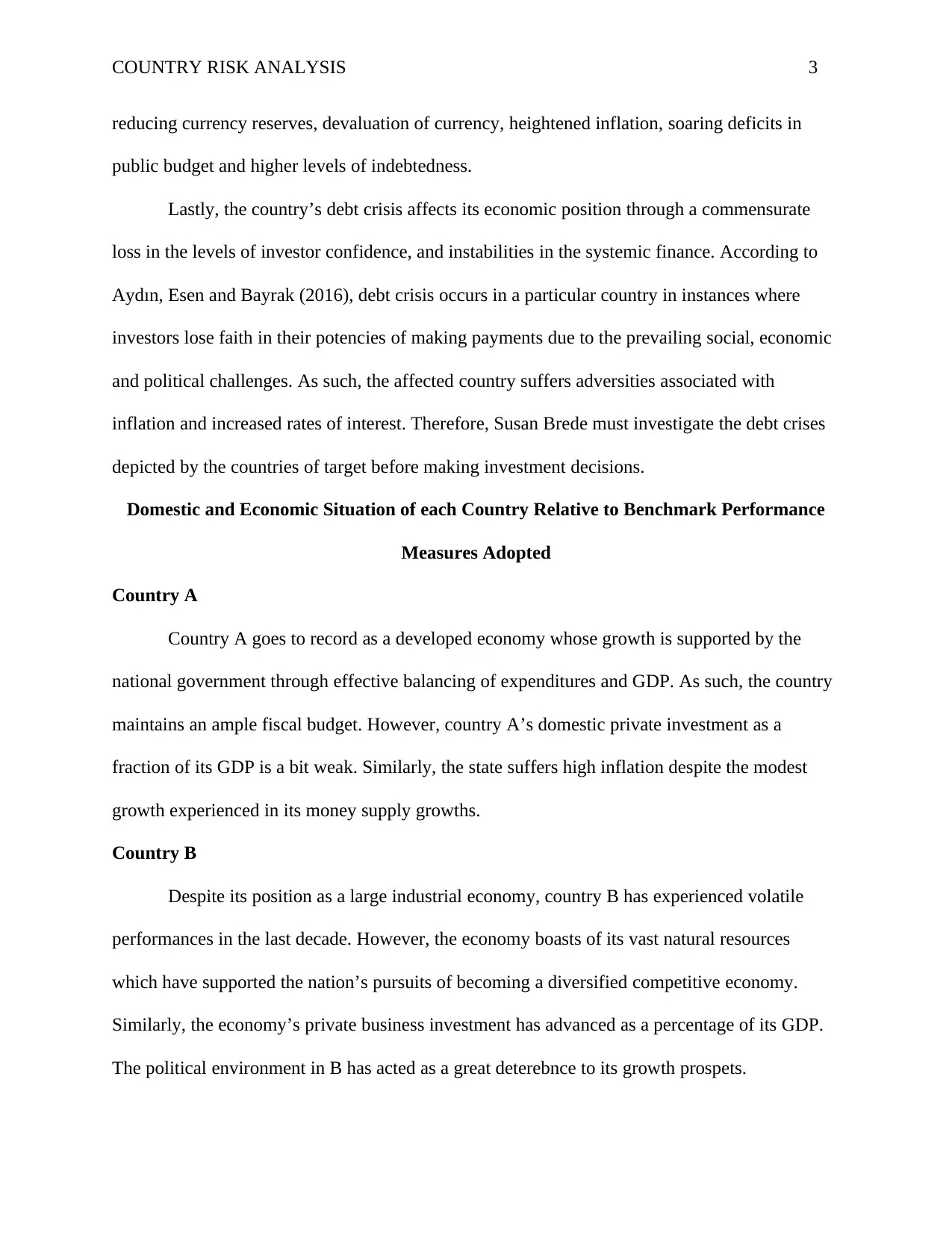
COUNTRY RISK ANALYSIS 3
reducing currency reserves, devaluation of currency, heightened inflation, soaring deficits in
public budget and higher levels of indebtedness.
Lastly, the country’s debt crisis affects its economic position through a commensurate
loss in the levels of investor confidence, and instabilities in the systemic finance. According to
Aydın, Esen and Bayrak (2016), debt crisis occurs in a particular country in instances where
investors lose faith in their potencies of making payments due to the prevailing social, economic
and political challenges. As such, the affected country suffers adversities associated with
inflation and increased rates of interest. Therefore, Susan Brede must investigate the debt crises
depicted by the countries of target before making investment decisions.
Domestic and Economic Situation of each Country Relative to Benchmark Performance
Measures Adopted
Country A
Country A goes to record as a developed economy whose growth is supported by the
national government through effective balancing of expenditures and GDP. As such, the country
maintains an ample fiscal budget. However, country A’s domestic private investment as a
fraction of its GDP is a bit weak. Similarly, the state suffers high inflation despite the modest
growth experienced in its money supply growths.
Country B
Despite its position as a large industrial economy, country B has experienced volatile
performances in the last decade. However, the economy boasts of its vast natural resources
which have supported the nation’s pursuits of becoming a diversified competitive economy.
Similarly, the economy’s private business investment has advanced as a percentage of its GDP.
The political environment in B has acted as a great deterebnce to its growth prospets.
reducing currency reserves, devaluation of currency, heightened inflation, soaring deficits in
public budget and higher levels of indebtedness.
Lastly, the country’s debt crisis affects its economic position through a commensurate
loss in the levels of investor confidence, and instabilities in the systemic finance. According to
Aydın, Esen and Bayrak (2016), debt crisis occurs in a particular country in instances where
investors lose faith in their potencies of making payments due to the prevailing social, economic
and political challenges. As such, the affected country suffers adversities associated with
inflation and increased rates of interest. Therefore, Susan Brede must investigate the debt crises
depicted by the countries of target before making investment decisions.
Domestic and Economic Situation of each Country Relative to Benchmark Performance
Measures Adopted
Country A
Country A goes to record as a developed economy whose growth is supported by the
national government through effective balancing of expenditures and GDP. As such, the country
maintains an ample fiscal budget. However, country A’s domestic private investment as a
fraction of its GDP is a bit weak. Similarly, the state suffers high inflation despite the modest
growth experienced in its money supply growths.
Country B
Despite its position as a large industrial economy, country B has experienced volatile
performances in the last decade. However, the economy boasts of its vast natural resources
which have supported the nation’s pursuits of becoming a diversified competitive economy.
Similarly, the economy’s private business investment has advanced as a percentage of its GDP.
The political environment in B has acted as a great deterebnce to its growth prospets.
⊘ This is a preview!⊘
Do you want full access?
Subscribe today to unlock all pages.

Trusted by 1+ million students worldwide
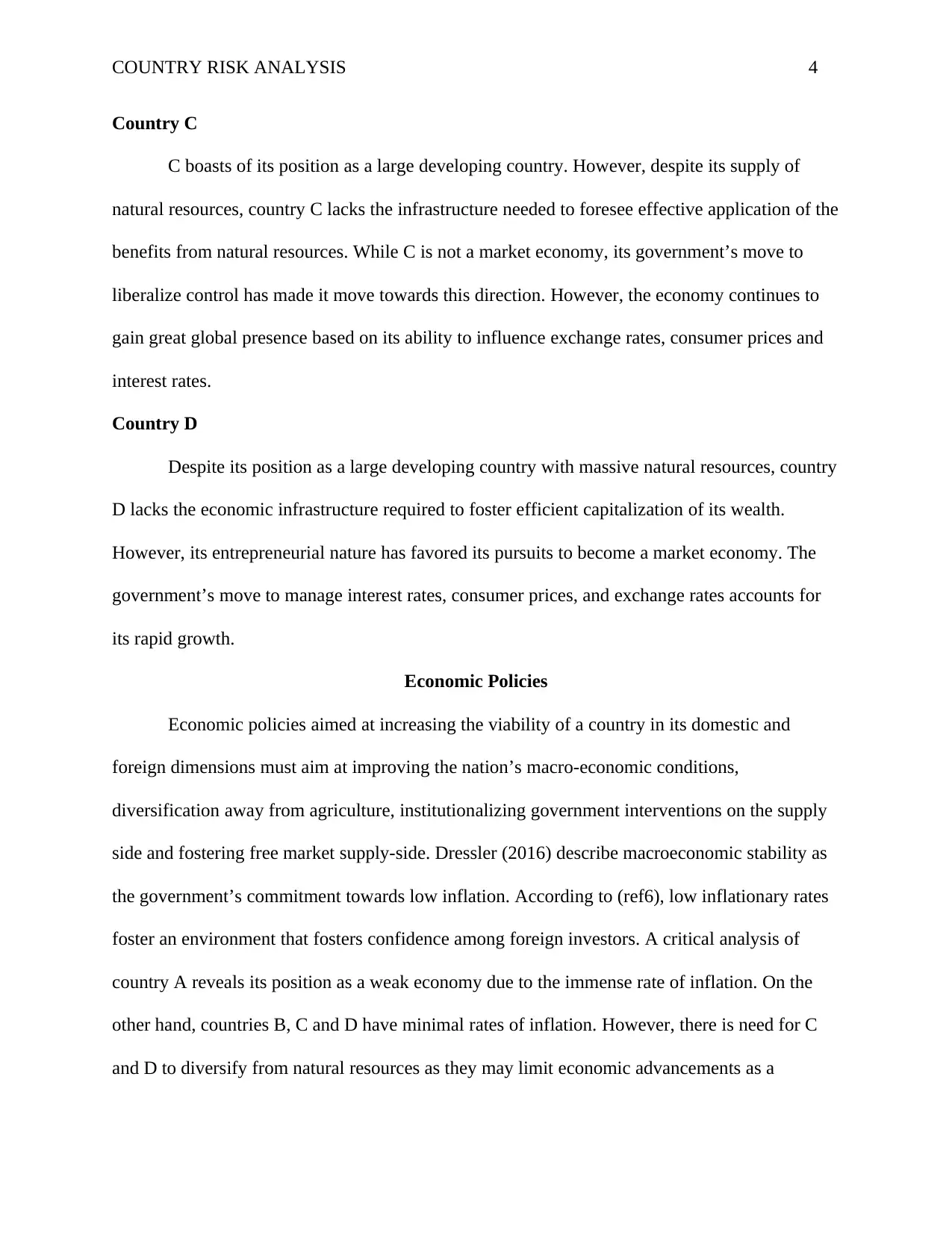
COUNTRY RISK ANALYSIS 4
Country C
C boasts of its position as a large developing country. However, despite its supply of
natural resources, country C lacks the infrastructure needed to foresee effective application of the
benefits from natural resources. While C is not a market economy, its government’s move to
liberalize control has made it move towards this direction. However, the economy continues to
gain great global presence based on its ability to influence exchange rates, consumer prices and
interest rates.
Country D
Despite its position as a large developing country with massive natural resources, country
D lacks the economic infrastructure required to foster efficient capitalization of its wealth.
However, its entrepreneurial nature has favored its pursuits to become a market economy. The
government’s move to manage interest rates, consumer prices, and exchange rates accounts for
its rapid growth.
Economic Policies
Economic policies aimed at increasing the viability of a country in its domestic and
foreign dimensions must aim at improving the nation’s macro-economic conditions,
diversification away from agriculture, institutionalizing government interventions on the supply
side and fostering free market supply-side. Dressler (2016) describe macroeconomic stability as
the government’s commitment towards low inflation. According to (ref6), low inflationary rates
foster an environment that fosters confidence among foreign investors. A critical analysis of
country A reveals its position as a weak economy due to the immense rate of inflation. On the
other hand, countries B, C and D have minimal rates of inflation. However, there is need for C
and D to diversify from natural resources as they may limit economic advancements as a
Country C
C boasts of its position as a large developing country. However, despite its supply of
natural resources, country C lacks the infrastructure needed to foresee effective application of the
benefits from natural resources. While C is not a market economy, its government’s move to
liberalize control has made it move towards this direction. However, the economy continues to
gain great global presence based on its ability to influence exchange rates, consumer prices and
interest rates.
Country D
Despite its position as a large developing country with massive natural resources, country
D lacks the economic infrastructure required to foster efficient capitalization of its wealth.
However, its entrepreneurial nature has favored its pursuits to become a market economy. The
government’s move to manage interest rates, consumer prices, and exchange rates accounts for
its rapid growth.
Economic Policies
Economic policies aimed at increasing the viability of a country in its domestic and
foreign dimensions must aim at improving the nation’s macro-economic conditions,
diversification away from agriculture, institutionalizing government interventions on the supply
side and fostering free market supply-side. Dressler (2016) describe macroeconomic stability as
the government’s commitment towards low inflation. According to (ref6), low inflationary rates
foster an environment that fosters confidence among foreign investors. A critical analysis of
country A reveals its position as a weak economy due to the immense rate of inflation. On the
other hand, countries B, C and D have minimal rates of inflation. However, there is need for C
and D to diversify from natural resources as they may limit economic advancements as a
Paraphrase This Document
Need a fresh take? Get an instant paraphrase of this document with our AI Paraphraser
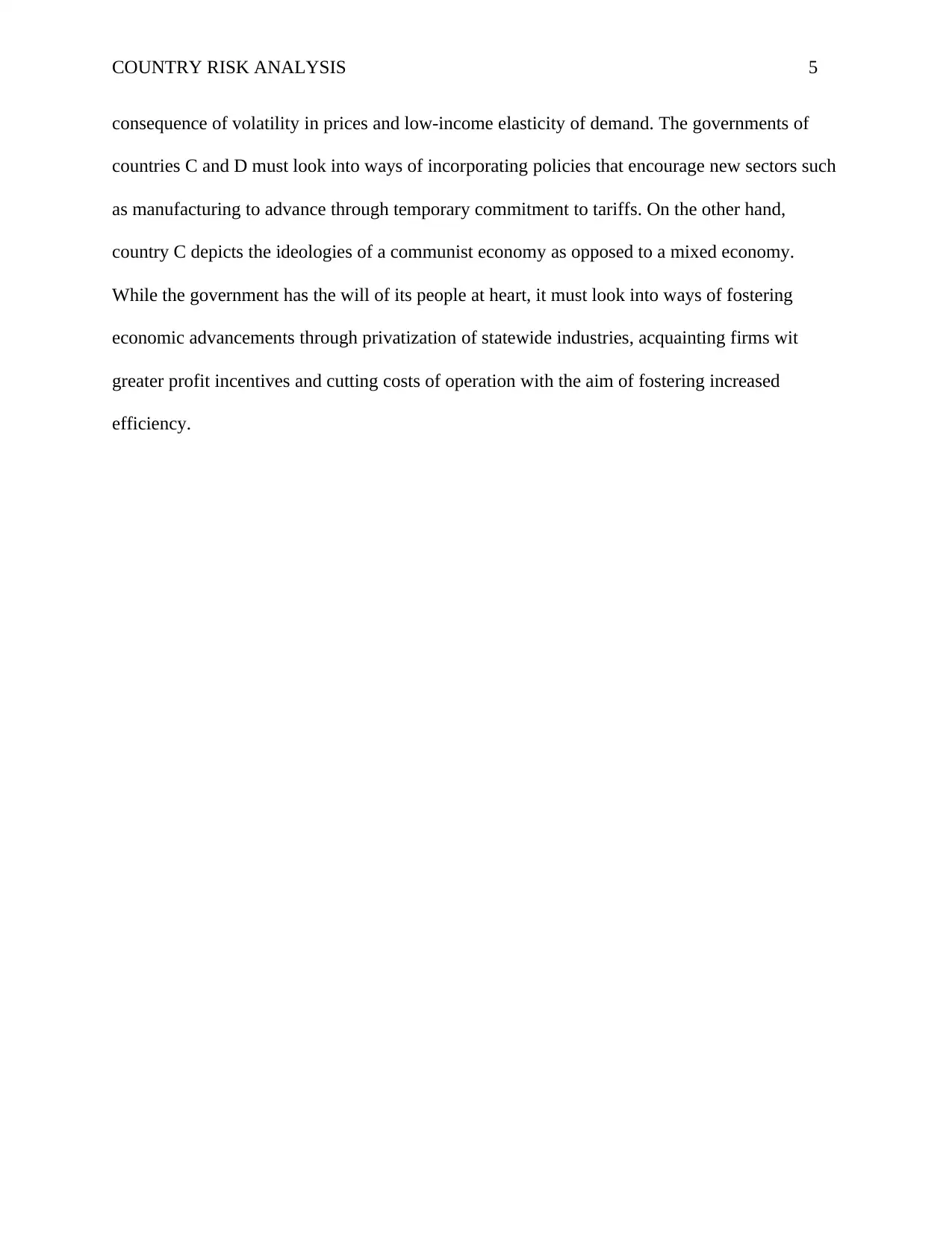
COUNTRY RISK ANALYSIS 5
consequence of volatility in prices and low-income elasticity of demand. The governments of
countries C and D must look into ways of incorporating policies that encourage new sectors such
as manufacturing to advance through temporary commitment to tariffs. On the other hand,
country C depicts the ideologies of a communist economy as opposed to a mixed economy.
While the government has the will of its people at heart, it must look into ways of fostering
economic advancements through privatization of statewide industries, acquainting firms wit
greater profit incentives and cutting costs of operation with the aim of fostering increased
efficiency.
consequence of volatility in prices and low-income elasticity of demand. The governments of
countries C and D must look into ways of incorporating policies that encourage new sectors such
as manufacturing to advance through temporary commitment to tariffs. On the other hand,
country C depicts the ideologies of a communist economy as opposed to a mixed economy.
While the government has the will of its people at heart, it must look into ways of fostering
economic advancements through privatization of statewide industries, acquainting firms wit
greater profit incentives and cutting costs of operation with the aim of fostering increased
efficiency.
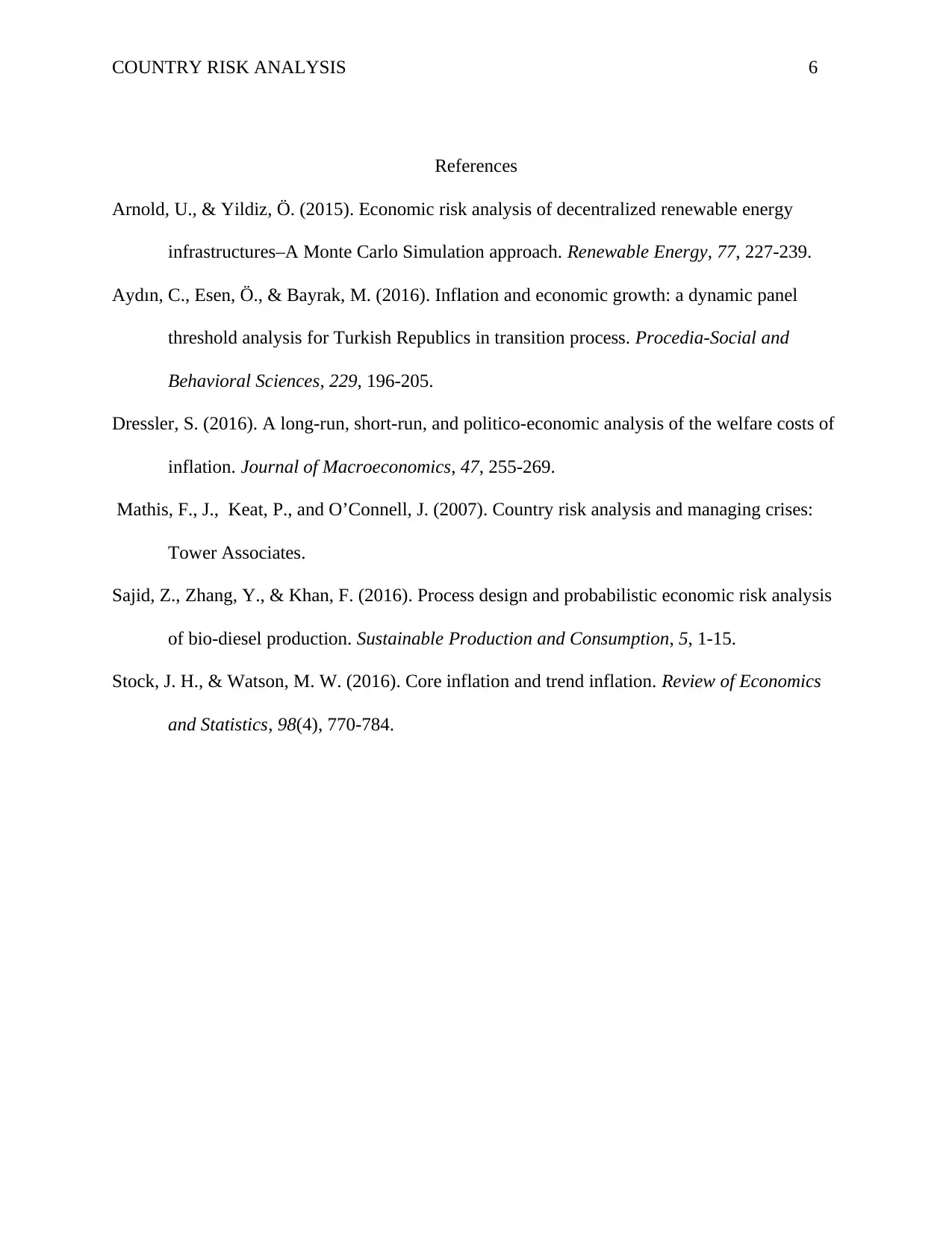
COUNTRY RISK ANALYSIS 6
References
Arnold, U., & Yildiz, Ö. (2015). Economic risk analysis of decentralized renewable energy
infrastructures–A Monte Carlo Simulation approach. Renewable Energy, 77, 227-239.
Aydın, C., Esen, Ö., & Bayrak, M. (2016). Inflation and economic growth: a dynamic panel
threshold analysis for Turkish Republics in transition process. Procedia-Social and
Behavioral Sciences, 229, 196-205.
Dressler, S. (2016). A long-run, short-run, and politico-economic analysis of the welfare costs of
inflation. Journal of Macroeconomics, 47, 255-269.
Mathis, F., J., Keat, P., and O’Connell, J. (2007). Country risk analysis and managing crises:
Tower Associates.
Sajid, Z., Zhang, Y., & Khan, F. (2016). Process design and probabilistic economic risk analysis
of bio-diesel production. Sustainable Production and Consumption, 5, 1-15.
Stock, J. H., & Watson, M. W. (2016). Core inflation and trend inflation. Review of Economics
and Statistics, 98(4), 770-784.
References
Arnold, U., & Yildiz, Ö. (2015). Economic risk analysis of decentralized renewable energy
infrastructures–A Monte Carlo Simulation approach. Renewable Energy, 77, 227-239.
Aydın, C., Esen, Ö., & Bayrak, M. (2016). Inflation and economic growth: a dynamic panel
threshold analysis for Turkish Republics in transition process. Procedia-Social and
Behavioral Sciences, 229, 196-205.
Dressler, S. (2016). A long-run, short-run, and politico-economic analysis of the welfare costs of
inflation. Journal of Macroeconomics, 47, 255-269.
Mathis, F., J., Keat, P., and O’Connell, J. (2007). Country risk analysis and managing crises:
Tower Associates.
Sajid, Z., Zhang, Y., & Khan, F. (2016). Process design and probabilistic economic risk analysis
of bio-diesel production. Sustainable Production and Consumption, 5, 1-15.
Stock, J. H., & Watson, M. W. (2016). Core inflation and trend inflation. Review of Economics
and Statistics, 98(4), 770-784.
⊘ This is a preview!⊘
Do you want full access?
Subscribe today to unlock all pages.

Trusted by 1+ million students worldwide
1 out of 6
Related Documents
Your All-in-One AI-Powered Toolkit for Academic Success.
+13062052269
info@desklib.com
Available 24*7 on WhatsApp / Email
![[object Object]](/_next/static/media/star-bottom.7253800d.svg)
Unlock your academic potential
Copyright © 2020–2025 A2Z Services. All Rights Reserved. Developed and managed by ZUCOL.





